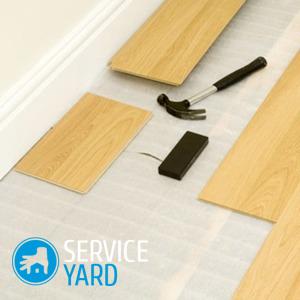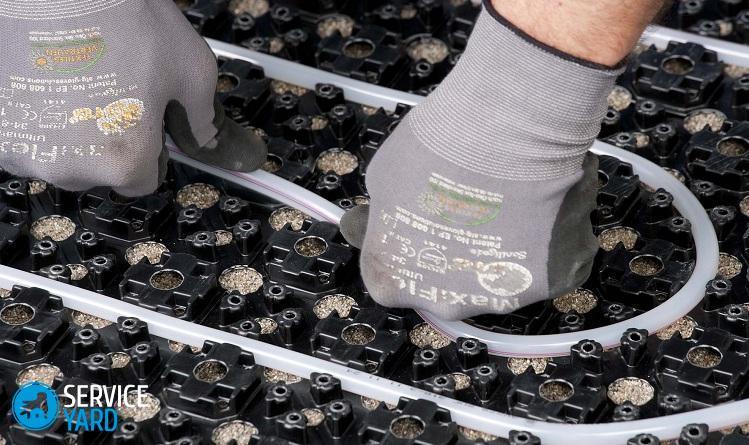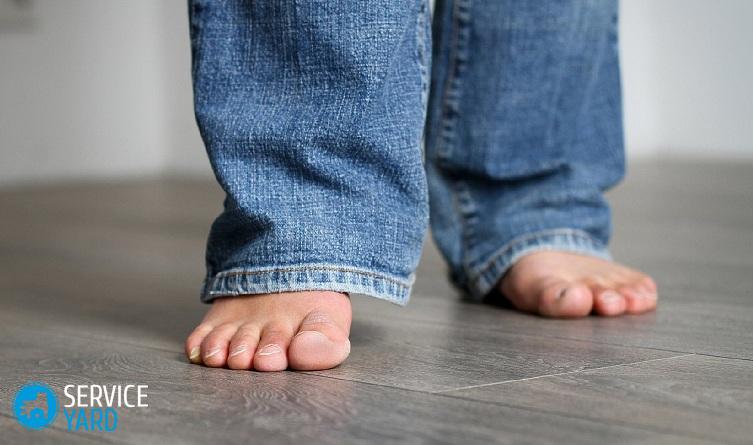Which coating is best for a warm water floor?

The design of underfloor heating, based on water technologies, involves the presence of a decorative floor covering, which plays the role of not only decoration, but also is a conductor of heat into the room from heating elements. Parquet, laminate, and even ceramics can be used as finishing materials for such floors. Today we will try to find out which coating is better for a warm water floor, because when choosing a material, it is necessary to take into account the operating features of the heating water mechanism.
to contents ↑The use of ceramics for waterborne floor heating
Warm floors are usually used in rooms where the feet are constantly in contact with the floor. Such rooms in any house are a bathroom, toilet, kitchen, bedroom, corridor and children's room. The most durable and wear-resistant coating for a warm water floor should be bought in the bathroom and kitchen. How to choose a coating specifically from the available range?
Experts recommend giving preference to ceramic tiles, because in comparison with other materials it has several advantages, namely:
- moisture resistance;
- absolute indifference to the use of chemical cleaners;
- simplicity in terms of care.
Important! Due to these qualities, ceramics has become almost the only possible option for finishing the floor in the bathroom and in the kitchen.
The only minus of the tiles is the low temperature, which is why it is not very comfortable to stand on such a coating after a shower. This problem is solved by underfloor heating equipment.
The main features of ceramic floor heating are:
- Ceramics conduct heat very well, so if it is constantly being supplied from below, it will be a pleasure to walk on this floor.
- Stone and ceramic coatings are ideal for underfloor heating, since only they have indicators of thermal inertia and thermal conductivity. Moreover, the harder and thicker the tile will be, the higher the listed characteristics will be.
- If floor heating is the main source of heat, then tiles need to cover the maximum proportion of the total area of the apartment. Only under this condition can all the advantages of underfloor heating be fully appreciated.
- Even if the tile is used as a decorative element, it still improves the efficiency of the warm floor.
- During laying in the adhesive layer, thin cables are mounted, which greatly facilitates the wiring of all wires.
- Due to the ability to adjust the thickness of the tile finish, you can also adjust the thermal power of the floor itself.
Features of laying ceramics on a warm water floor
The warm water floor is covered with ceramic tiles in the following sequence:
- A cement-sand mortar is prepared, with which then a screed will be poured on top of the finished structure.
- The poured screed should be left to dry for a while, only then proceed with further work.
- Using tile glue, the tile is attached to the working surface, and the glue is applied both to the tile and to the floor.
- The tile element is laid on the floor, pressed as hard as possible to the surface.
- Check how flat the floor should be with a horizontal building level, so that it does not work out under a slope.
- The joints between the tiles should be perfectly even. To make it easier to work, you can buy special plastic crosses, which are used specifically for aligning ceramic squares.
- The tile will dry out for about a day. And after that, grouting is carried out using a rubber spatula. You can grout with an epoxy or cement adhesive.
to contents ↑Important! After carrying out all these measures, you need to leave the tile for a couple of days until completely dry, after which it is safe to turn on the water heating system.
The use of wood flooring to finish the water floor
If for yourself you have already answered the question of which flooring to choose for a warm floor, and settled on wood, then you certainly need to get acquainted with all the features of this natural raw material. You should know the following about wood flooring:
- The tree is characterized by insufficient heat conductivity, which is why experts do not recommend using it when covering underfloor heating. Such a coating will be a kind of barrier between the space of the room and the heating elements.
- The wood is unstable to temperature extremes and high humidity, so quickly enough after the start of operation, it begins to swell or shrink.
Important! Under normal operating conditions, such problems with wooden coatings do not occur. But when it comes to the water floor, then troubles should be expected at any time, since different temperature conditions in autumn and winter, spring and summer can provoke them.
In the warm season, the system is practically not used, and in winter it works at full capacity. And such a sharp jump in temperature can lead to deformation, delamination of the wood and the appearance of cracks.
Secrets of wood floor heating
If you decided on such a step and chose exactly wood as the finishing material for the warm floor, then use the advice of specialists:
- Among all materials, exotic wood species are considered the most suitable for flooring on warm water floors. And the raw material must necessarily be as solid, dense, resistant to shrinkage, to have good thermal conductivity.
Important! Such materials include bamboo, teak, oak, acacia and rosewood.
- Before starting work, the wood must be properly dried, because the material even with an 8% moisture level can not be laid, otherwise - after laying the finished floor will strongly settle.
- When determining the most suitable color, it is better to dwell on dark shades, which is also due to shrinkage of the floor covering. On a dark parquet, cracks that often occur due to floor deformation are not visible.
- The coating details should be as thin as possible so as not to interfere with the heat entering the room. The ideal thickness does not exceed one centimeter.
- Before laying, you need to warm up the room, that is, gradually turn on the entire heating system.
To satisfy all of the above requirements, according to experts, they can only:
- lamella and industrial flooring;
- end floor from transverse saw cuts;
- wood panels and parquet mosaic.
to contents ↑Important! All the auxiliary materials must meet the same criteria for high heat conductivity and resistance to temperature extremes. It is recommended to install the finishing layer using polyurethane glue, and it is better to lay the parquet mosaic using wax or special oil.
Application for covering underfloor heating of other materials
And for those who have not yet decided how to cover the warm floor in the house, the following information will be very useful. It is possible to cover a warm water floor with the help of such materials.
Laminate and Carpet
In fact, if the previous options seemed too expensive or simply unsuitable for you, then you can even choose a carpet or laminate as a finishing material.
They have good thermal conductivity and thermal inertia, on the basis of which, we can confidently say that they are ideal for laying on the floor in a children's room or bedroom. Such a coating not only conducts heat from the heating elements, but also perfectly retains it for a long time indoors.
Important! Installation of these materials is quite simple, the main thing is that the screed is even and a polymer substrate is used.
Linoleum
It is better not to cover warm floors with linoleum, since it does not meet the requirements of environmental safety and thermal conductivity. Although it is cheap, it does not conduct heat well, and when it gets very hot, it starts releasing toxic substances hazardous to health.
Important! You can lay it on a warm water floor only in one case: if the coating itself is made of natural materials. But it is worth considering that such a linoleum cloth will be very expensive.
PVC coating
Finishing water heat-insulated floors can also be done with flexible materials based on PVC. But when choosing, you need to make sure that the material has a special mark, which indicates that it can really be used with the heating system in apartments.
to contents ↑Important! Their advantages include insignificant thickness, tolerance of expansions and contractions, as well as resistance to temperature changes.
Stock footage
Using all the above data, you can easily decide which is better to lay on a warm water floor. In addition, the solution to this issue largely depends on how actively you plan to heat the apartment through underfloor heating and in which areas.
- How to choose a vacuum cleaner taking into account the characteristics of the house and coatings?
- What to look for when choosing a water delivery
- How to quickly create comfort at home - tips for housewives
- How to choose the perfect TV - useful tips
- What to look for when choosing blinds
- What should be running shoes?
- What useful things can you buy in a hardware store
- Iphone 11 pro max review
- Than iPhone is better than Android smartphones





